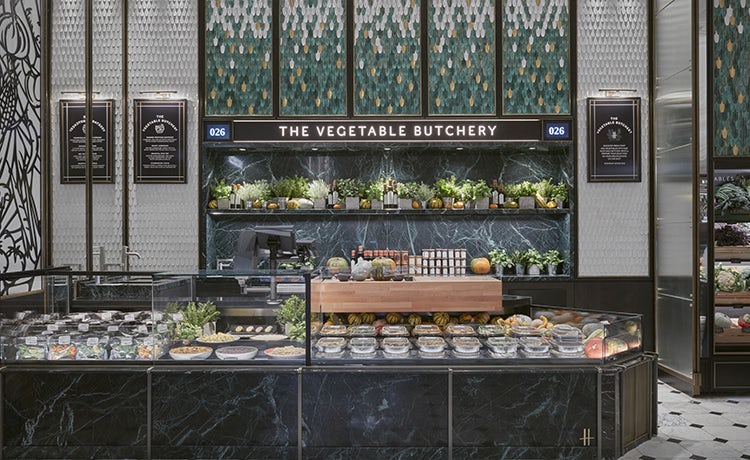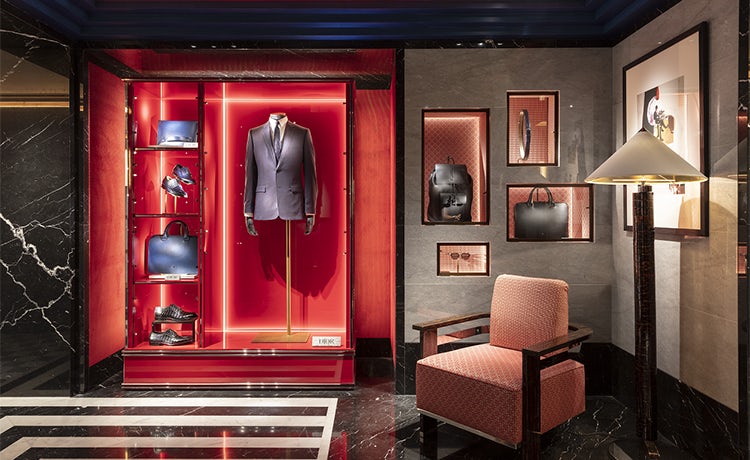The luxury department store’s first chief marketing and customer officer is instead championing a customer-centric approach based on personal interactions and elevating the in-store experience beyond the high street as it looks to win “the race to the top”.

Pessimism on the high street has come to characterise most reports of UK retail over the past year. However, unlike their mainstream counterparts that have been forced into adopting risk-averse strategies and fallen into the trap of habitual discounting, luxury department stores have continued to champion the importance of creativity and ramped up their level of investment during this challenging period.
A notable example is Harrods, which is two years into a £200m redevelopment of its Knightsbridge store intended to cater to the requirements of the modern luxury shopper. The timing of the investment comes as Harrods’ most recent annual results reveal the department store grew its gross transaction value by 6.8% to £2.1bn during the year to 3 February 2018, with turnover increasing by 4.6% to £862.5m.
During this period the luxury retailer saw its profit after tax rise 8.7% to £176.7m.
There has also been a strategic shift closer to the customer, marked by the appointment of the department store’s first chief marketing and customer officer, Amanda Hill. At the time of her appointment in April 2018 Harrods managing director, Michael Ward, described the position as “a strategically important new role for the business”, focused on delivering an “unparalleled customer experience”.
Hill came to the retailer after nearly three years with US broadcaster A+E Networks and more than 13 years at the BBC, where she served as chief brand officer. Thrust into a newly-created role during a slump for the wider high street, Hill quickly realised there has never been a better time to offer shoppers a real point of difference.
I really don’t believe in segmentation in the way marketers traditionally talk about it, because it can make you relatively lazy.
Amanda Hill, Harrods
“Michael [Ward] talks a lot about the race to the top. It’s really easy to follow the discounting game and get stuck in that circle, whereas for a few years now the company has said ‘no, we’ve got to invest in a better environment, a better experience and keep elevating it’,” she states.
“That’s quite a remarkable feat to invest at a time when it’s hard and I think one of the reasons why Harrods has been able to continually grow is that instead of battening down the hatches it said ‘we’re going to go to the top and we’re going to elevate everything even further’.”
The in-store environment is central to this ambition. Harrods redeveloped around 125,000sq ft of its Knightsbridge store last year, with a further 60,000sq ft of developments currently underway.
This includes the opening of the men’s superbrands floor, the second stage redevelopment of the food halls, a new look toy department and the completion of its fine watches and jewellery department. In fact, during this fiscal year alone Harrods has redeveloped an area the size of Liberty and Harvey Nichols combined.

This spring the retailer will unveil its next generation beauty hall, spanning two floors and featuring dedicated areas for demonstrations and masterclasses, with the menswear and sports floor set to launch before 2020. At 154,650sq ft, this particular floor will be the largest of its kind in the world.
Strategic move
In the newly-created role, Hill has a remit spanning brand strategy, marketing, communications, visual merchandising, CRM, customer service, digital, personal shopping, media campaigns and operations.
She does not, however, consider her role wide ranging. Her approach is to start by thinking carefully about the customer and let the objectives flow from there. So, while bespoke events and one-to-one individual conversations work really well for the deeply loyal and very private high net worth customer, with the Chinese consumer the objective is to engage them when they are outside the UK by enabling them to transact directly via WeChat.
Hill’s philosophy is to simplify the task by thinking less about the products and more about the customer. Her focus is on fulfilling a lifestyle need for customers, many of whom visit the department store upwards of 50 times a year. For this reason, Hill has no desire to lump her customer base into different segments according to their purchase behaviour.
“I really don’t believe in segmentation in the way marketers traditionally talk about it, because it can make you relatively lazy and actually it’s impossible to lump our customers into any kind of bucket,” she explains.
“You have to think about Harrods from a product perspective like a collection of incredible niches and each part is so distinctive. You can’t bucket the Harrods customer into any neat group, which makes our approach even more customer-centric.”

Reflecting specifically on her job title, Hill expects to see more CMOs take on the role of chief customer officer. She notes the main difference compared to 20 years ago is that there are so many more levers marketers can use to reach consumers across different touchpoints along the luxury customer journey.
READ MORE: Are chief customer officers just CMOs in disguise?
Hill argues that the brand experience would feel “incredibly schizophrenic” for customers if she ran emails in one part of the business, events in another and personal shopping elsewhere. It is therefore important to find people who can navigate all the different platforms, but then think narrative first.
“Imagine if I spent all my time doing advertising or sending emails but we forgot that when we said hello when the customer came through the doors and did such a bad job that they didn’t come back?” Hill asks.
“The reason all those touchpoints are being joined up and put under that role is that actually a lot of the marketing we do at Harrods is not above-the-line, or fancy advertising, it’s actually about one-to-one bespoke relationships and personal interactions.”
Protecting the brand heritage
Ward’s clear vision for the future of the business was one of the main reasons Hill was so excited to join the company as she prizes the ability to work for a leader who knows exactly what they want the business to be. In fact, the move to the 170-year-old luxury retailer did not feel like a big leap despite Hill having spent the past 16 years working in TV.
“Harrods has got more similarities to the BBC than I ever thought when I first entered. When I was CMO at the BBC you felt like you’d almost been given this duty of care to look after something that had an incredible heritage,” she explains.
“At Harrods it’s like you become a guardian and the real onus is on protecting where it’s come from. Your role is a lot more about making sure it remains relevant and you continue to push it forward, but you’re one of the many people who will touch it and then you hand it onto the next people who will take care of it.”
A lot of the marketing we do at Harrods is not above-the-line, or fancy advertising, it’s actually about one-to-one bespoke relationships and personal interactions.
Amanda Hill, Harrods
One of the first things Hill did when taking on the role was to articulate the Harrods story. She spent four months listening to store staff to get a rich sense of the brand. Her biggest challenge – and what still excites her most about the role – is getting her head around the vastness of the Harrods business.
She describes it as a brand with no one customer, product set or mono-brand, but rather a collection of niches each with its own distinct character, all of which deserve respect.
“A lot of CMOs will come in and do a new positioning, they’ll change what they think the brand is about and actually that’s not what you do with Harrods,” Hill explains.
“You almost become like a brand historian. You think, how do I make sure I retain that ‘special sauce’ and how do I make sure I make it increasingly relevant to the consumer? What you don’t do is come in and try to reinvent something.”
Rethinking the role of digital
This year Harrods wants to explore the increasingly important role of content in the digital environment, especially given that when deployed effectively it has been shown to more than double the retailer’s online sales conversion rate. Hill’s team is also starting to rethink the role digital plays for a luxury brand like Harrods, both in terms of pure commerce and discovery.
“There may be things that we need to put online that will never sell online, but will actually be a discovery mechanic for the store. So you will have a different set of KPIs and metrics,” she explains.
“We will be thinking of digital not just as an ecommerce play on a pure website, but actually there are many more ways that I can buy physically using digital as the mechanic. For example, lots of sales already go through WeChat and I’m sure that’s going to increase. Everyone can get fixated with a website, rather than thinking what is the role of digital for a luxury brand.”
Another area of focus in 2019 will be the roll out of Harrods’ new brand positioning, the Art of the Possible. The marketing team have broken the year up into six chapters based on the conversations they feel are most pertinent to today’s luxury market.
The new positioning kicked off online and in-store on 11 January with the Art of Colour, which champions the “joy and optimism” of colour during what is widely considered one of the dreariest times of year.

The concept will be supported by in-store experiences and partnerships, including a tie-up with colour experts Pantone on an exclusive Harrods spring 2019 colour palette. Consumers will also be able to book onto events including colour workshops and panel discussions with leading authorities on colour.
READ MORE: How brands are using colour to influence purchase decisions and change perceptions
With the new brand positioning underway and as she closes in on her first anniversary at the luxury retailer, Hill sees 2019 as a period of “piecing the jigsaw together” to ensure the team unites to deliver a seamless experience for customers.
“We’ve been on quite a journey and it’s a remarkable team, but we’ve never been pieced together this way before, we’ve never collaborated this way before or worked cross-functionally in this way before,” she explains.
“Organisational redesign is often talked about as a thing that is a set of boxes. It’s as much about the organisational rewiring and the people who have to interact with that and that’s what is exciting when you see what this team of people can do when they come together.”
Hill intends to keep her approach simple and focus not just on the big picture £200m store redevelopments, but on the tiny details of everyday luxury like sourcing the best beef or the finest honey to spread on your toast, in a bid to help Harrods win the race to the top.
[“source=marketingweek”]


